Content moves deals — why else would it always be in such high demand (and your marketing team so pressed)?
But knowing which content to share with which buyers and when to share it makes sales less of a guessing game and more of a science.
And that’s data EVERYONE wants. We learned as much during our recent live webinar and poll covering enablement content frustrations (represented below).
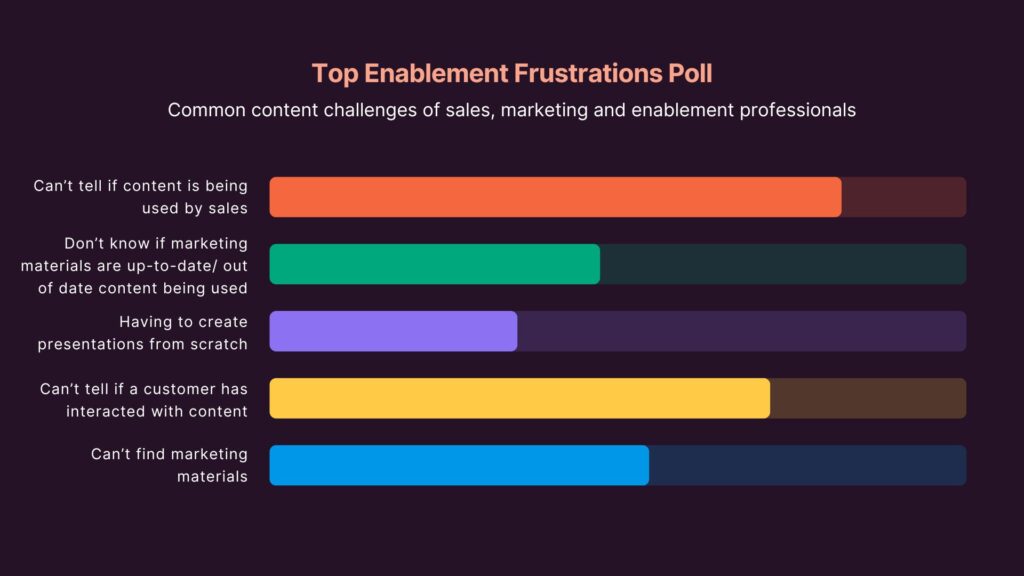
Because getting insight into how buyers are engaging with content tells you which actions to take to improve your team’s sales process to scale close rate increases across the team.
Plus, buyers get a better experience and you gain their trust. Basically, everyone wins.
Sounds great, but how does it work?
Our in-house experts break down the process of moving from buyer engagement insights to meaningful action when it comes to using content engagement data to improve sales processes, buying experiences, and close rates. Below are the metrics they highlighted, using our own solution, Bigtincan, as an example (since Bigtincan uses Bigtincan).
Buyer engagement insights for sales directors
Content to Opportunity Phase
To know when your sellers should share certain pieces of content from your company’s catalog, you’ll need to know which content is having the most impact along each phase of the opportunity.
In Bigtincan, you can see this across the entire CRM solution with a custom-built dashboard (like the one shown below).
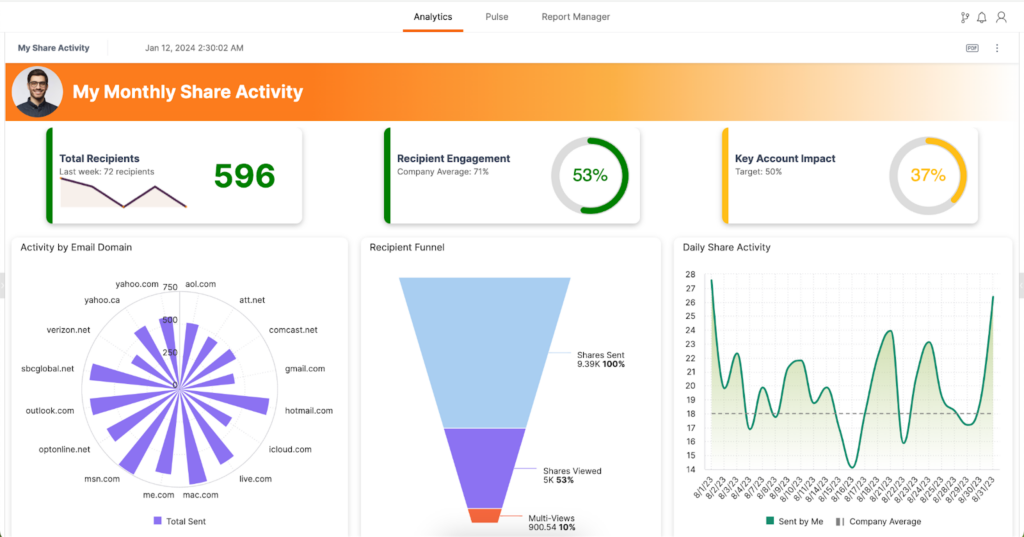
You can see each rep’s individual activity correlated with CRM data. That lets you compare their activity and impact to the company average or targets and see how their actions during the sales cycle are having an impact.
This dashboard answers:
- What content is most impactful at which stage of the funnel?
- How can I replicate that positive impact?
- When I try adding different content to my cadences, how does that impact engagement?
Content Contributing to Close
Beyond knowing when to use content so it moves buyers to the next phase of the sales cycle, you’ll want to know what content actually helps CLOSE the deal once and for all. (This one is basically the Holy Grail for revenue teams.)
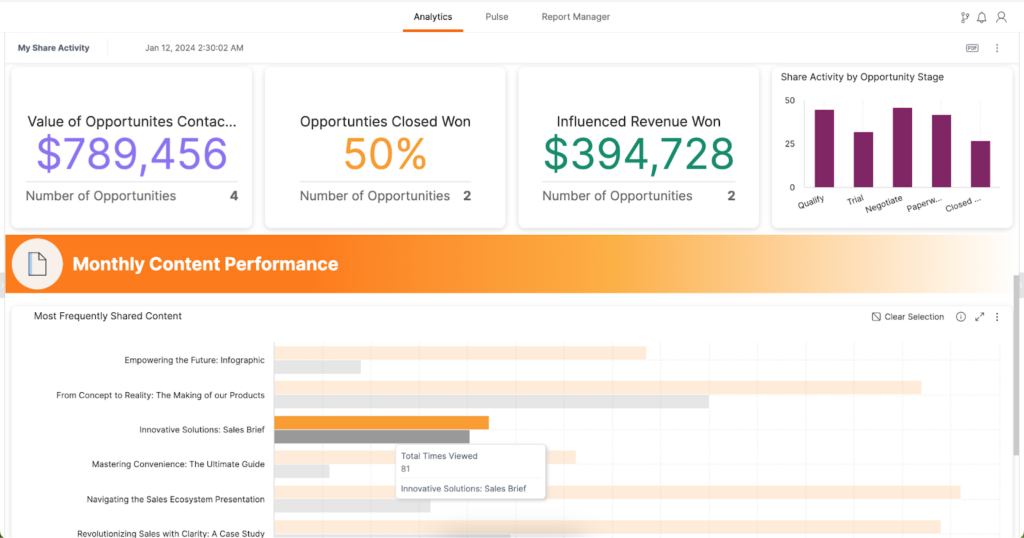
In a custom dashboard like the one above, you can take an aggregated look at what reps are sharing most frequently and drill into how much influence each piece of content has on sales.
This is paramount to understanding what content is working and actually influencing revenue — which helps the whole revenue organization beyond just your sales team.
This dashboard answers:
- What content is being used along closed won opportunity journeys?
- When in the cycle is it being shared, and what amount of revenue has it influenced?
- Can I find trends among the most influential content — are there any similarities like format or topic so I can tell marketing to invest more on those types of content in the future?
- What content is being shared often but not being opened? Is there any adjustment needed to titles or format to make it more compelling to my buyers?
- What content is not impacting deals or could even be negatively impacting deals?
Content Attention (Share Opens)
Sales is a numbers game but it’s not JUST a numbers game. You have to consider the people driving the numbers — AKA your buyers.
Your buyers are as busy as you, if not more so since they’re actively seeking solutions, so what they choose to be worthy of their attention is a key insight into their concerns.
Knowing which pieces of content buyers opened, ignored, spent time on, downloaded, liked, or disliked helps guide your conversations to what matters most to them, and how you and your products can help them.
You can capture these insights using Bigtincan Digital Sales Rooms and Share Dashboards.
You can create a new, custom room for every buyer and load it up with the content that’s relevant to them, then wait and see how they interact with it.
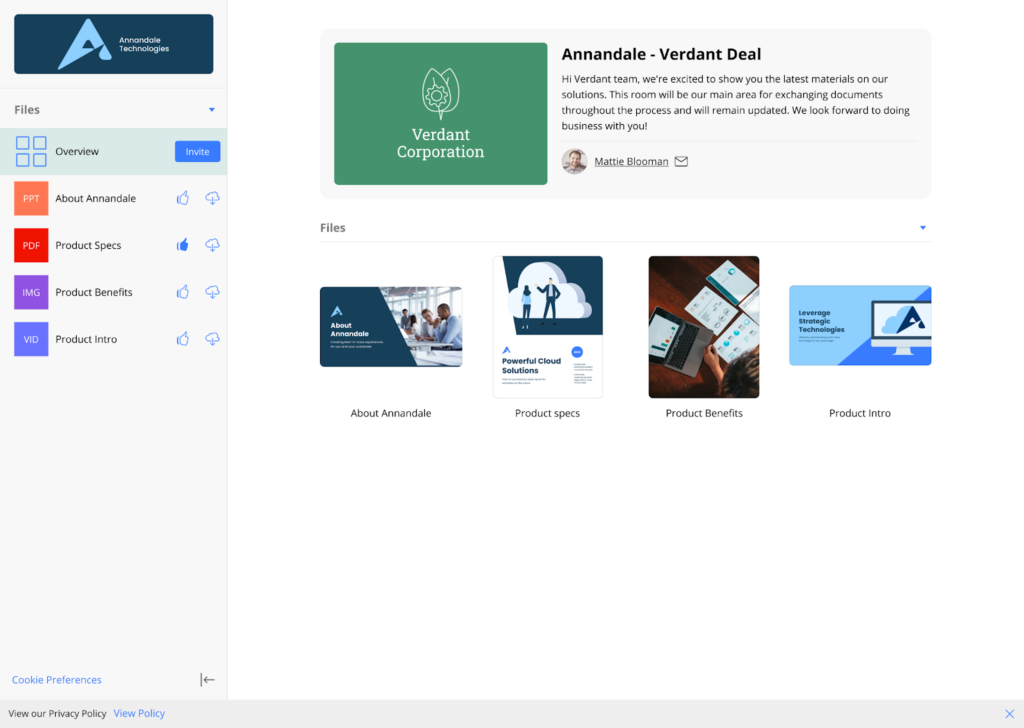
While reps keep an eye on individual rooms, sales directors can easily monitor all of the Digital Sales Room activity from a Bigtincan Analytics dashboard.
On the Dashboard you can get a full list of successful and unsuccessful shares, including who they were shared with and the number of times they were viewed.
One particular panel that helps sales and marketing teams is understanding the top shared files that were viewed by customers.

You can even set up notifications to alert you when a KPI like success rate of shares falls below a certain threshold (pictured here).
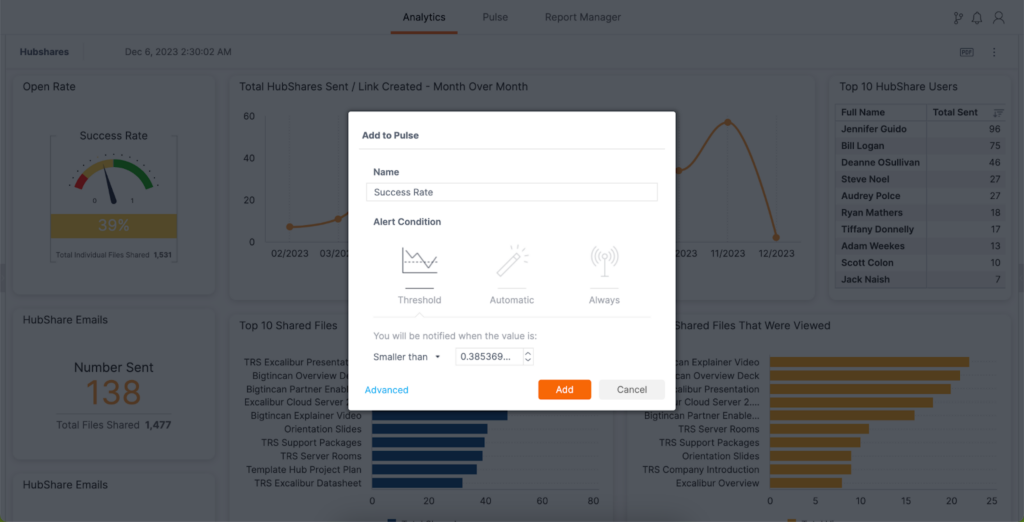
When using HubShare Rooms and Dashboards pay close attention to:
- Which content are customers opening?
- Which topics or pieces of content do they ignore?
- How much time are they spending on each file or slide?
- What pieces of content are they liking and downloading within the Digital Sales Room (DSR)?
You can see DSRs in action in this short overview:
Actions sales managers can take to increase sales KPIs
Buyers not opening a piece of content?
Then you know you’ve missed the mark with that buyer. If it happens frequently, then you know to take that content out of rotation so your sellers stop sharing it.
Share that feedback with marketing so they know to remove it from content repositories and not create more content like it.
Buyers closing the content quickly?
Look at which page or slide was their “exit point.” What’s on that slide and before it?
Maybe your deck is too long, maybe it isn’t getting to the point quickly enough and needs to be rearranged or cut down (or both), maybe the title was just misleading, or maybe it just wasn’t right for those buyers.
Similar to the previous point, if it happens a few times, it’s a buyer-specific issue. If it happens all the time, it’s a content or messaging problem that needs to be addressed with marketing.
Buyers lingering on a certain slide or page while ignoring others?
Use these insights to guide your next interactions so your buyer feels you understand their problems and interests.
Note which slides they spent time on and which they ignored. Edit the slide deck or document to remove the pieces buyers ignored so when you share it with buyers with a similar profile, they’re only getting the good stuff. If you have more content related to the pages they spent time on, send that to them next or add it to their Digital Sales Room so you keep them engaged.
Then, if needed, work with your enablement and/or marketing teams to create more of the content that resonated for use in future deals.
Are buyers downloading a document from the Digital Sales Room?
Bingo! That’s what you want to see. That’s the piece of content that tells them exactly what they need to know, and now they’ve downloaded it to refer to later or even share it with their buying committee or decision maker.
Be sure to follow up with some questions about that content. Find out if they need further explanation on any of the information it contains or you can also send them any similar content you have. It may be a good time to prompt for another call — they may start looping in more stakeholders or decision makers.
Does a piece of content have mixed success in increasing close rates?
Check to see when sellers are sharing it during the sales process.
Drill into the times when it has worked. What’s the commonality there? Are successful sellers sharing it closer to close or earlier in the buying journey? Find out what high performers are doing and replicate that process with your other sellers so you have a repeatable process that can increase rates across the team.
You should also look at how they’re introducing the piece to their buyers.
Are they dropping into emails without context? Are they emphasizing the value to the buyer and how it’s relevant to them? If needed, work with them on the language they use to introduce content so the emphasis is on value.
Real life, non-hypothetical example of buyer engagement insights to action
We're not the only ones putting this into practice. And no one can tell the story better than our customers. You can hear FieldTurf's story straight from them below.
We've integrated Salesforce into Bigtincan which has been a huge help for our sales team. They can track what type of content they've sent to which prospects.
-Iannick Di Sanza Marketing Coordinator at FieldTurf
The takeaway?
- Use buyer engagement insights to update sales processes with recommended content per stage.
- Work with sales enablement and marketing to create more of the winning content.
- Get your reps following the same process through short training sessions on content usage to craft a repeatable, successful sales process that serves buyers better.
Want more insights and guidance to improve your team’s sales processes and close rates?
Follow Bigtincan on LinkedIn and YouTube for updates and get a copy of this data-packed guide while you’re at it:
Enablement Just Got Personal: How to resolve the personal frustrations holding your business back